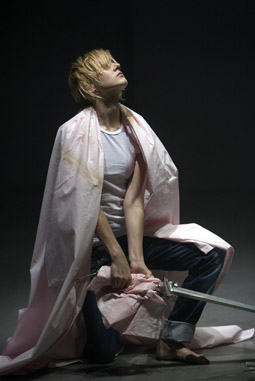 |
Silvia Costa, Hey Girl!, Socìetas Raffaelo Sanzio photo Peter Manninger |
The white woman undresses the black woman, and my anxiety rises. The men leave the stage. All except one white man who, unlike the others, is in 19th century costume, including top hat. He holds out a hand toward the black woman, exhibiting her, offering her. My anxiety increases. The white woman whispers to the black woman, “I’m so sorry.” She then leaves her with the man, who fetches a pile of hay, and leads the black woman to it. He chains her. This, more than anything, is what I don’t want to see. I don’t want to see a female slave auctioned off like a mule on a pile of straw. The man holds out his inverted top hat. The white woman observes the slave woman through four discs—like windows—hanging one behind the other. The windows are streaked and dirty. What image of the slave is the white woman seeing through these glass veils?
Above, the lines from Romeo and Juliet’s balcony scene are projected on a large screen: “How camest thou hither, tell me, and wherefore?…the place death, considering who thou art, if any of my kinsmen find thee here.” “With love’s wings did I o’erperch these walls; For stony limits cannot hold love out.” Where is love in this triangle? And to whom do I attribute the lines? Is the black woman Juliet, the white woman Romeo? Or is the man with top hat either? All of them, none of them? The white woman now digs into her low-rider jeans and produces some coins. She walks to the auctioneer and pays the fee. Is this simple complicity or is she paying for the slave’s freedom? I feel my heart may be breaking. It’s been coming for some time, this sense of grief welling up. Then something shatters. I think I feel a membrane burst in my chest. But it’s the four windows, which all at once have exploded in mid-air, showering the stage with glass.
I’m crying. It’s been coming since the beginning, when the white girl-woman first emerged, chrysalis-like, from the slime of a latex cocoon, when she first crawled like a new-born calf across the strange fluorescent landscape, which is also a soundscape where distant melodies arrive as if through a ventilation shaft. The images from the misty landscape are dense and shifting: a massive broad-sword out of the middle ages next to a bottle of perfume and a tube of lipstick; the girl-woman kneeling, like Joan of Arc, pledging allegiance—but to what? God, king, church, capitalism? Whatever it is, it isn’t hers; it’s an imposition that’s going to use and betray her—as Joan was betrayed. “Dost thou love me? I know thou wilt say ‘Ay’; And I will take thy word.” The girl-woman holds up a sheet, which has just had an ‘x’ burned into it by the giant sword. She stands at the center of that ‘x’, perhaps unconsciously making herself a target.
What’s this about, this heaving in my chest, this performance? I think it’s about one woman’s experience of being a woman. And me, a man sitting in the auditorium? It’s about one man’s imagining of that woman’s experience. It’s about the betrayal of this woman —of women, of innocence, of trust and of love. And it’s about making contact with those things momentarily, making and losing it at the same time. It’s also about sitting in awe at the work of art unfolding before me, at the restless shifting of symbols: first a big bass marching drum, then that drum being held by a naked woman, then the woman weeping over it, then the woman pounding it with the mallets while weeping. Meanings accumulate, line up side by side without cancelling each other out. The black woman is a slave. The black woman is painted silver by the white woman and given a sword. The silver-painted, armoured black woman puts on high heels. What is feminine, what is masculine, what is submission, what is rebellion? Hey Girl! doesn’t collapse these things to a single point. It enfolds meanings then distributes them liberally. There is plenty of room in this world for my personal ache and wonder.
Hey Girl! gets a hold of me and doesn’t let go for 75 minutes. It ended at 8:45 last night. It’s now almost noon and I’ve barely slept. I keep turning the images over in my head, the ones I drank in and the ones I couldn’t look away from. Director Romeo Castellucci, his designers, and the two women, Silvia Costa and Sonia Beltran Napoles, did that rare thing: they dislodged my thinking, allowing the images to bypass my mind and go directly to my body. They fed me, and they made me see what I didn’t want to see. “Therefore pardon me, And not impute this yielding to light love, Which the dark night hath so discovered.”
Socìetas Raffaelo Sanzio, Hey Girl!, director, design, lights, costumes Romeo Castellucci, performers Silvia Costa, Sonia Beltran Napoles, original music Scott Gibbons, statics and dynamics Stephan Duve, lighting technique Giacomo Gorini, Luciano Trebbi, sculptures Plastikart, Istvan Zimmerman; Frederic Wood Theatre, University of British Columbia, Jan 23-26; PuSh International Festival of Performing Arts, Jan 16-Feb 3
Alex Lazaridis Ferguson is a theatre artist based in Vancouver. He writes plays, acts, and occasionally directs. He's also a founding member of the performing poetry ensembles, AWOL Love-Vibe and VERBOMOTORHEAD. His writings on theatre have appeared in publications such as Canadian Theatre Review, The Boards, Transmissions.
RealTime issue #83 Feb-March 2008 pg. 8
© Alex Ferguson; for permission to reproduce apply to [email protected]








 back
back